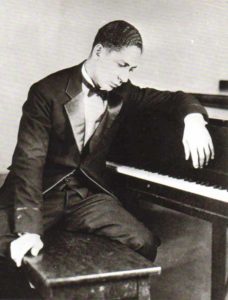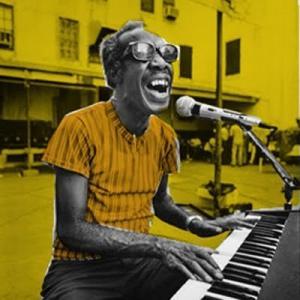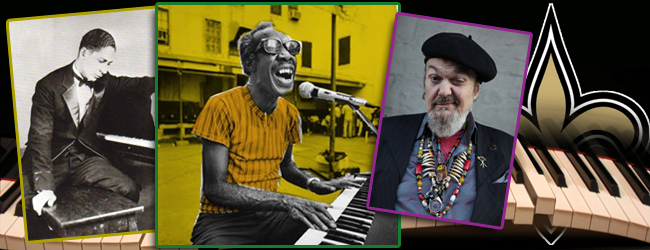
New Orleans piano styles constitute an important part of the contribution New Orleans has made to American music. Broadly, this contribution can be divided into two historical moments: the first one corresponds to the birth and development of early Jazz and is dominated by a man named Jelly Roll Morton. Jazz was highly influenced by ragtime, but it was much more than ragtime. Morton added a shuffling swing rhythm to ragtime’s syncopation, and created a powerful melodic idiom that still seems fresh today. Morton also tried to capture the roles of the different instruments of the Jazz band in his solo piano playing: the octave melodies representing trumpet lines, the tenor octaves the trombones, the clarinet-like passage work in the right hand, as well as the rest of the rhythm section in activity by both hands. Few of the people he influenced were recorded in his day. Tuts Washington mentioned one of them, Joseph Louis “Red” Cayou, who was active in New Orleans in the early 1920s. Today there are a number of Jelly Roll Morton specialists who attempt to preserve his style the way he played it, notably Butch Thompson, Bob Greene, James Dapogny, and Tom McDermott.
The second historical moment of New Orleans piano comes at the end of 1940s when Roy Byrd, aka Professor Longhair, put Latin rhythms together with a Blues shuffle. His first recording was in 1949, of “Mardi Gras in New Orleans” and “She Ain’t Got No Hair.” (Bandleader Dave Bartholomew was making the same connection between the shuffle and Latin rhythms in an ensemble context around the same time.) At that time there was no body of popular dance music associated with Mardi Gras. Longhair both corrected that, and founded a style in a single song. His innovation represented a significant departure from the boogie-woogie based Blues that had dominated the pop blues scene since the 1920s, in New Orleans and everywhere else. Latin music, particularly from Cuba, had been seeping into American popular music since the 1920s, and it became a torrent during the 40s. Byrd is said to have absorbed it while working on WPA projects throughout Louisiana in 1937. Ironically, it was Morton who had noticed the particular “Spanish tinge” in New Orleans music much earlier.

None of this is mysterious if looked at from the perspective of the diffusion of African style musics in the New World. The cultural mixture found in New Orleans had been unique in North America since the 18th century. The city of New Orleans absorbed a richer and more extensive dose of African musical traditions than anywhere else in the U.S., and it is the only U.S. city where French and Spanish cultures had established themselves. Music in these European cultures had a much broader and more pervasive role than in English culture, which held sway throughout the rest of America during the 18th and 19th centuries before the masses of immigrants from central and Eastern Europe and elsewhere arrived. And even if particular African musics hadn’t survived in New Orleans, African styles of music making and the importance of music as part of life definitely had, making New Orleans unique, both for the diversity of musical traditions found there, and the ease with which musicians absorbed new musical idioms. Elsewhere in the Americas, outside the U.S. Africans, originally imported as slaves, constituted a much greater proportion of the population and did conserve much more of their music-cultural heritage than they did in the U.S. Latin-American music sounds the way it does because it is much more heavily African influenced. New Orleans, with its constant flow of immigrants from Latin America and its role as a major trading port with the Caribbean and South America, was the logical place for Latin music to have an impact. Jazz had been the result of the combination of European and African traditions of music making, with a certain amount of Spanish-style syncopation, as discerned by Morton.
Latin-based music was integrated to an even greater degree in the second wave of musical innovation to come out of New Orleans, based on the creation of a new composite rhythm which transformed boogie-woogie style Blues, with its repetitive eighth-note triplet left hand rhythm, into what came to be known as Rhythm and Blues, or R&B for short; a term which was the designation used by record company owners for popular music which appealed to the African-American market. Although the strictly shuffle rhythms remained a vital force in this music, the new hybrid of shuffle-rumba or shuffle-mambo, which had been created by Professor Longhair became the most exciting new current in the music, and by the mid-fifties had filtered through to rock ‘n’ roll, a term coined by disk jockey Alan Freed for the blues-based music marketed to white record buyers.
By the mid-fifties, even though Billboard maintained separate charts for the R&B and the pop (or Rock ‘n Roll) markets, enough tunes did well on both charts to argue for an expansion of national popular tastes into a single main market that embraced a range of styles. So the New Orleans connection was essential to the development of the Blues, R & B and Rock ‘n Roll. Although it was a music that had been largely developed on the piano, what sold records were the vocals, so it wasn’t until much later that interest began to spread in the New Orleans R&B piano style.
There is a historical reason for this. Professor Longhair had developed his highly original piano style by the 1950s, and people like James Booker, Tommy Ridgely, Allen Toussaint and Eddie Bo had begun to adopt it themselves. But just as the style was forming its own identity around a community of players, musical fashion shifted away. The Beatles and other British rock groups transformed R&B and Rock ‘n Roll in the 1960s, widening it out from the Blues, broadening it’s themes to embrace social protest, drugs, and other preoccupations of the pop culture. The result was that New Orleans flavored music lost market share and the fortunes of its purveyors went into decline. This descent lasted until the mid-70s, when Professor Longhair was “rediscovered”; showcasing at the New Orleans Jazz Festival in 1971. Dr. John largely contributed to the revival interest in the city with his albums Gris-Gris in 1967 and Gumbo in 1972. New Orleans music began to take on new life both as a special province of rock music and as a valued part of the local culture of the city. The stars of the New Orleans piano style did well, putting out albums and going on European tours. More and more pianists in and around New Orleans studied the licks and rhythmic patterns of Professor Longhair, James Booker and Dr. John, to the point that some of them became commonplace.


1 Comment
An excellent article!! I have never seen the history of New Orleans piano summed up so beautifully and completely. It is a shame that so many of the piano geniuses from the Crescent City are not more widely recognized elsewhere.